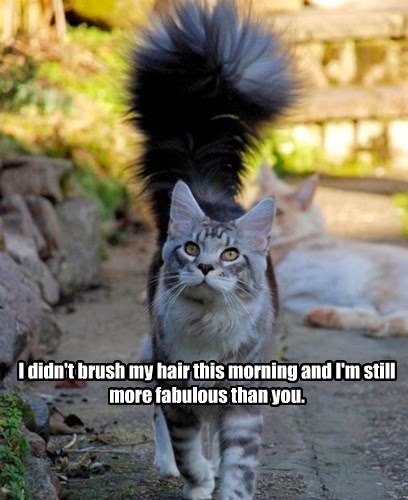Do you remember the commercial with eggs frying in a pan and the announcer is saying, "This is your brain on drugs."? With the use of drugs being so much higher now than when my kids were growing up, every parent is encouraged to have that talk with their kids. In this blog, I'm using that same theme to talk about catnip for cats. Hope you enjoy.
First of all, let's talk about what catnip is.
Nepeta cataria, or catnip, is a strong-scented mint that
contains a volatile oil that’s easily released into the air. Biting or
rolling on the plant crushes the leaves, and releases the oil so Kitty
can get a good sniff. It doesn’t take much. Cats can detect catnip oil
in the air at a saturation as low as one part per billion. Whoa! That's pretty amazing!
How does catnip affect your cat? Rather than a simple smell, the chemical in catnip resembles sedative
components also found in the valerian plant, which may be used in
natural therapies to calm pets and people. Catnip also may be similar to
one of the substances found in tomcat urine—yucky to you, but a lovely
smell to the cat! In fact, this pheromone in urine often triggers the
same sort of behavioral reaction in cats as exposure to catnip.
These types of chemicals, once inhaled, enter the cat's highly
specialized scenting organ through the roof of the mouth. The
vomeronasal, or Jacobson's organs, sit between the hard palate of the mouth and the septum of the nose,
and connect to the mouth via tiny conduits directly behind the cat’s
upper incisor teeth. You may see kitty perform an odd facial grimace with lips curled back and mouth open when employing this
organ.
The Jacobson’s organs are linked to the hypothalamus, an area of
the brain that acts like a switchboard to direct information to higher
centers. This part of the brain integrates taste and smell, motivates
appetite, and triggers a variety of behaviors.
Catnip in cats affects the same biochemical pathways that are affected
by marijuana and LSD in people. In its simplest terms, catnip is a
feline hallucinogen.The kitty "high" lasts from five to 15 minutes, and causes a loss
of inhibition. While the behaviors may look similar to cats-in-love,
catnip is NOT a feline aphrodisiac. It prompts similar behaviors in both
neutered and intact cats. Catnip-intoxicated cats act like furry fools
who roll and flop about on the floor, drool, and have a wonderful
relaxing time.
Cats rarely respond to catnip until they are about six months
old, and some cats never do. The trait is an inherited one, with only
two out of three domestic cats being affected; male cats seem to respond
more strongly than females. The quality of the catnip also influences
the response. With my two, Kirby reacts to it, but Sammy doesn't.
So, I'd like to emphasize the point again because if you don't...........
you might have to put up with these things!
Well! That story is for another time. Tell us about your cats and how silly they can get when they are around catnip. Would love to hear your comments.
Marion Lovato is the author of Sam, the Superkitty. Her book
describes an ordinary cat changing into a superhero to protect his
family from things that go bump in the night. Available on Amazon as a
paperback or Kindle edition.
http://www.amazon.com/gp/product/1604588667






















































